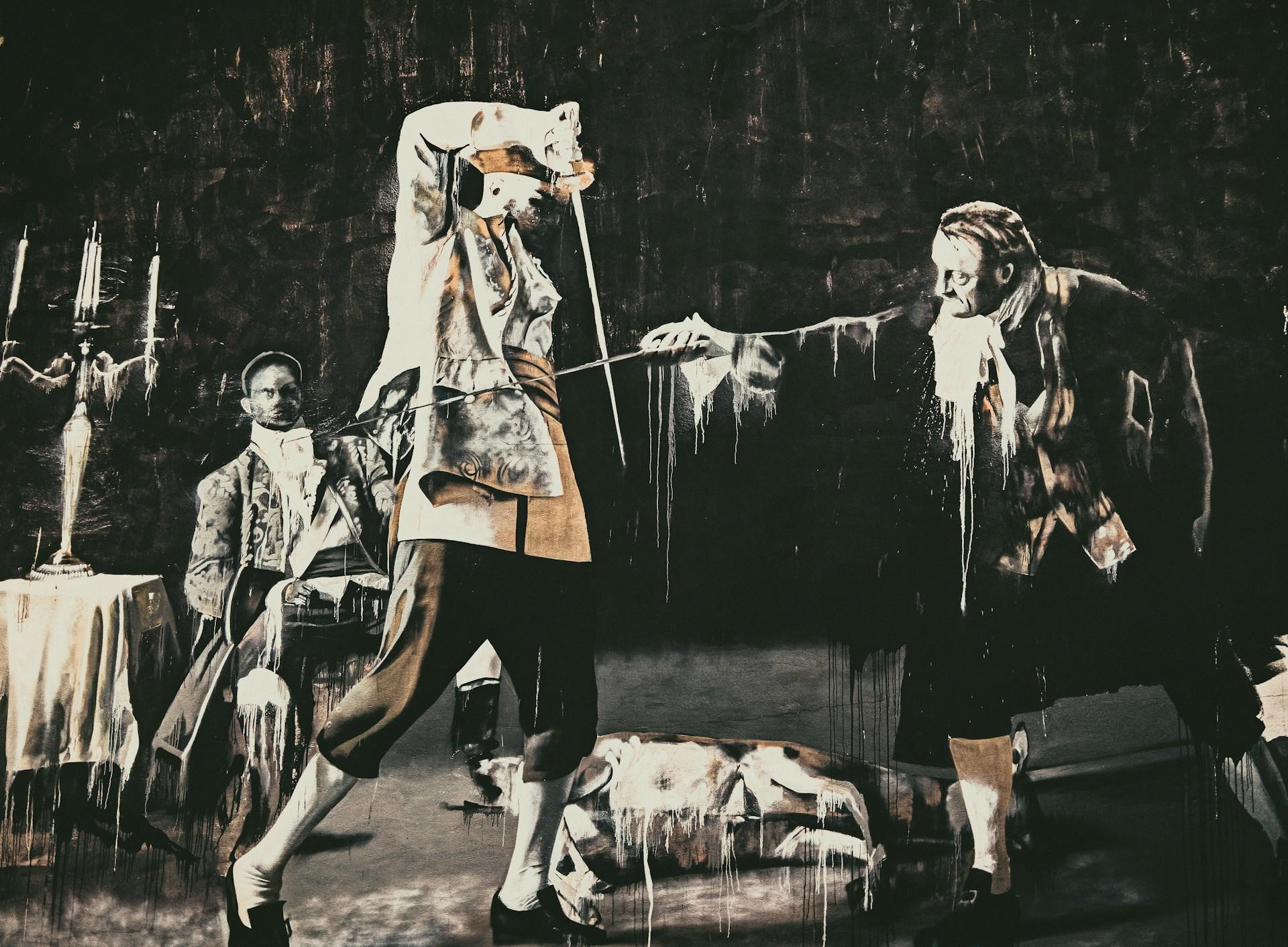American novelist and editor, E. L. Doctorow once said, "Good writing is supposed to evoke sensation in the reader — not the fact that it is raining, but the feeling of being rained upon.”
When it comes to evocative writing, William Shakespeare is undoubtedly at the forefront — having written many literary masterpieces that tug our heartstrings until today like Romeo and Juliet.
In this article, we will explore the following literary devices that enhanced the writing and language in this play:
- Rhymes and rhythm
- Foreshadowing and irony
- Imagery and symbolism
- Metaphor and simile

Rhymes and Rhythm
Rhymes and rhythm are key in adding structure and emotional depth to literary works. It helps the audience to recognise important themes and messages of the language through their poetic pattern and musicality — making the language both appealing to the emotions and pleasing to the ears.
One example that incorporates these two elements is a sonnet. A sonnet is written in 14 lines and follows an iambic pentameter rhythm with a specific rhyme scheme like this: ABAB CDCD EFEF GG. The last two lines end with a rhymed couplet (two lines that rhyme).
A type of rhythm in poetry where an unstressed syllable (soft beat) is followed by a stressed syllable (strong beat) and repeated five times.
Shakespeare uses sonnets to emphasise important events in Romeo and Juliet — to set the tone of a scene or to draw the audience to the characters' dialogues especially when it involves heightened emotions.
The most prominent sonnet of this play is featured in the very first act (the prologue), which gives the audience a clear background, setting, and an early spoiler of the play — tragedy awaits the main characters even before the characters appear on stage.
Two households, both alike in dignity (A)
- Act 1, Prologue
In fair Verona, where we lay our scene, (B)
From ancient grudge break to new mutiny, (A)
Where civil blood makes civil hands unclean. (B)
From forth the fatal loins of these two foes (C)
A pair of star-cross'd lovers take their life; (D)
Whose misadventured piteous overthrows (C)
Do with their death bury their parents' strife. (D)
The fearful passage of their death-mark'd love, (E)
And the continuance of their parents' rage, (F)
Which, but their children's end, nought could remove, (E)
Is now the two hours' traffic of our stage; (F)
The which if you with patient ears attend, (G)
What here shall miss, our toil shall strive to mend. (G)
Foreshadowing and Irony
The element of foreshadowing is integrated throughout the play. For instance, the audience knows that two young lovers will die right from the start. The foreshadowing coupled with moments of premonition of the main characters builds a heightened tension and immersion as the plot progresses.
Additionally, different forms of irony are also used to demonstrate the difference between expectation and reality in Romeo and Juliet.
Verbal Irony
This is when there is a difference between what is said by the characters and what is true.
When asked to marry Paris, Juliet says that she rather marry Romeo, whom she claims to hate when in fact she was already married to Romeo and loves him dearly.
I will not marry yet! And, when I do, I swear, It shall be Romeo, whom you know I hate, Rather than Paris.
- Act 3, Scene 5
Dramatic Irony
Dramatic irony pairs well with foreshadowing to make the whole plot more engaging. It gives the impression that the audience knows what lies ahead as compared to the characters.
For instance, the audience knows that Romeo and Juliet will eventually take their own lives despite having to watch them fall in love and get married.
Another clear example is that the audience knows that Juliet took the sleeping potion and faked her death. This dramatic irony makes the whole act and subsequent scenes more tragic when Romeo finally arrives at her tomb and takes his life without knowing the full truth.
Situational Irony
This literary device is usually present when the plot reaches its climax, or when there is an unexpected plot twist. In Romeo and Juliet, two of the greatest situational irony take place when Tybalt kills Mercutio and when Romeo kills Tybalt.
Initially, it was Romeo who avoided a confrontation with Tybalt after marrying Juliet, despite being provoked by him.

Things took a different turn when Mercutio stepped in to fight Tybalt, only to end up dying.
Mercutio's death triggered Romeo deeply, causing him to kill Tybalt against his initial wish.
Imagery and Symbolism
Like foreshadowing and irony, imagery and symbolism also share a close connection to make a literary work more vivid and meaningful.
Imagery, as the term implies refers to the descriptive language used to create a vivid image or impression of a particular scene.
Often, imagery acts as a point of reference to highlight something with symbolic meaning. For instance, Shakespeare uses the image of a rose to highlight Juliet's steadfast love towards Romeo even if he is a Montague, a family rival of the Capulets.
JULIET: "What's in a name? That which we call a rose. By any other name would smell as sweet."
- Act 2, Scene 2
In terms of imagery, just as a rose looks good and smells good, it would still retain its original characteristics even when it has another name.
Juliet wants Romeo and the audience to know that he is worthy of her love despite being a Montague. He is still perfect in her eyes and his family background is not an obstacle to their love.

Rose also symbolises love and beauty, two fundamental elements of the passionate romance of these two young lovers.
Metaphor and Simile
Both metaphor and simile are used to make comparisons, and these two literary devices are widely and aptly used throughout this play, especially by the main leads — Romeo and Juliet.
The main difference between these two is that, metaphor is used to create a direct association between something to another thing whereas simile is often followed by keywords such as "like" and "as".
Refer to the table below for a clear distinction with the following examples from the play.
| Example | Literary Device Type | Timeline | Significance |
|---|---|---|---|
| ROMEO: Love is a smoke made with the fume of sighs; | Metaphor | Act 1, Scene 1 | In the beginning of the play, Romeo described love as smoke — something that disappears quickly and filled with diappointments and sadness. He was thinking about his unrequited love for Rosaline Capulet as he was saying this. |
| ROMEO: It seems she hangs upon the cheek of night Like a rich jewel in an Ethiope's ear, | Simile | Act 1, Scene 5 | Romeo describes Juliet's beauty as something that standouts so brightly like a jewel in a dark background. This is when he falls in love at first sight with Juliet at her family feast. |
| JULIET: O serpent heart, hid with a flowering face! | Metaphor | Act 3, Scene 2 | Upon hearing that her cousin, Tybalt was killed by Romeo, Juliet was filled with shock. She uses this metaphor to describe a hidden dangerous side of Romeo (like a serpent) behind his beautiful face. |
| JULIET: It is too rash, too unadvised, too sudden, Too like the lightning, which doth cease to be. | Simile | Act 2, Scene 2 | Juliet compares her relationship with Romeo to the swiftness of a lightning — it appears and disappears quickly. It is similar to Romeo's metaphor of love in the beginning, which serves as a foreshadow of their brief love story. |
Learning these literary devices will give you a new appreciation and understanding when studying this play, and help you score well on your GCSE English Literature paper.












